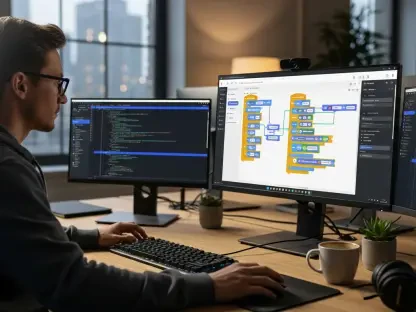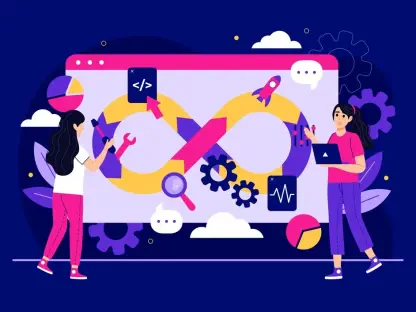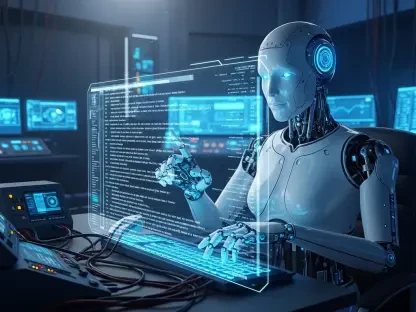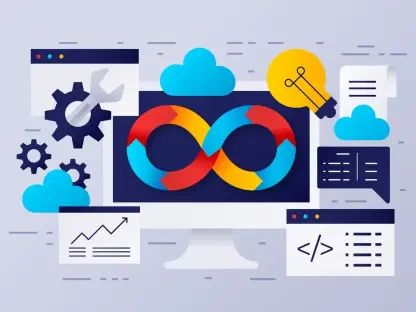The software development industry stands at a pivotal moment, where artificial intelligence (AI) tools are reshaping the very fabric of how code is written and projects are delivered, creating both opportunities and challenges. With the rise of intuitive, AI-driven approaches often dubbed “vibe coding,” developers can now produce complex solutions with unprecedented speed, relying on automation for tasks that once demanded hours of manual effort. Yet, beneath this wave of efficiency lies a pressing concern: could this reliance on AI be eroding the foundational skills that future engineers need to innovate and solve problems independently? This industry report delves into the transformative impact of AI in coding, examining both its remarkable benefits and the potential risks it poses to the long-term expertise of engineering talent.
The Rise of AI in Software Development
AI integration in software development has surged dramatically, becoming a cornerstone of modern programming practices. Vibe coding, characterized by its intuitive reliance on AI to interpret natural language inputs and generate code, has emerged as a game-changer for developers across skill levels. This approach allows for rapid prototyping and problem-solving, often bypassing traditional step-by-step coding processes in favor of automated outputs tailored to user intent.
Key players like Anthropic with its Claude Code, built on advanced language models, and Microsoft with frameworks such as AutoGen, are leading the charge in this space. These tools enable the automation of intricate tasks, from writing scripts to debugging entire applications, reducing the manual workload significantly. Their scope extends beyond mere assistance, offering solutions that adapt to complex project requirements with minimal human oversight.
The significance of this trend cannot be overstated, as it redefines productivity benchmarks in the tech sector. AI-driven tools are not just accelerating development cycles but also reshaping how engineering teams operate, allowing focus to shift toward strategic innovation rather than repetitive coding chores. This transformation signals a broader shift in the industry, where efficiency and speed are becoming paramount in competitive markets.
Benefits and Innovations of AI Coding Tools
Efficiency and Productivity Gains
AI coding tools are revolutionizing workflows by automating mundane and time-consuming tasks that have long plagued developers. Functions such as bug detection, code refactoring, and automated test creation are now handled with precision by AI, slashing the time spent on routine maintenance. This allows teams to allocate more energy to tackling high-level challenges and creative problem-solving.
Real-world applications underscore the value of these tools in accelerating development timelines. For instance, companies leveraging AI have reported faster prototyping cycles, enabling them to iterate on product features at a pace previously unimaginable. Such efficiency gains mean that projects which once took months can now be completed in weeks, providing a competitive edge in fast-moving industries.
This shift also fosters an environment where innovation thrives, as developers are freed from the minutiae of coding to explore novel solutions. The ability to quickly test and refine ideas through AI assistance ensures that businesses can respond agilely to market demands, maintaining relevance in a landscape driven by constant change.
Democratizing Development for All Skill Levels
One of the most profound impacts of AI in coding is its ability to lower barriers to entry, empowering developers regardless of experience. Junior coders, often daunted by the complexity of large-scale projects, can now engage with sophisticated systems thanks to AI’s guided support. This democratization enables less experienced individuals to contribute meaningfully to high-stakes initiatives.
Market dynamics reflect this shift, with startups achieving substantial output despite limited team sizes. Industry leaders like Garry Tan, CEO of Y Combinator, have noted that AI allows small groups to deliver software at a scale once reserved for larger, well-funded organizations. Such trends are reshaping resource allocation, making technology more accessible to emerging businesses with constrained budgets.
This broadening of access also cultivates diversity in the tech field, as individuals from varied backgrounds can now participate in development without needing years of formal training. The ripple effect is a more inclusive industry, where talent and creativity, rather than just technical pedigree, drive progress and innovation.
Risks of Overreliance on Vibe Coding
The allure of AI-driven coding comes with significant pitfalls, particularly the potential erosion of core engineering skills. As developers increasingly depend on automated tools to solve problems, there is a risk that fundamental competencies, such as manual debugging and algorithmic thinking, may diminish over time. This dependency could leave the workforce unprepared for scenarios where AI falls short or requires human intervention.
Junior developers face a unique challenge in this context, as easy access to AI solutions might deter them from engaging in the hands-on learning crucial for deep expertise. Bypassing the trial-and-error process that builds critical thinking means they may struggle to understand the underlying mechanics of code, limiting their ability to innovate independently or address novel issues.
Looking ahead, the long-term consequence could be a scarcity of senior engineers equipped with battle-tested problem-solving abilities. If the current generation leans too heavily on automation without cultivating resilience and adaptability, the industry might face a talent gap, lacking leaders capable of navigating complex, uncharted technical challenges in future projects.
Balancing AI and Human Expertise
Navigating the integration of AI in development requires careful consideration of regulatory and ethical frameworks to preserve essential skills. Guidelines must be established to ensure that reliance on automation does not overshadow the need for human proficiency. This includes setting standards for when and how AI tools should be used, particularly in educational and professional settings.
Structured development programs and mentorship practices remain vital in complementing AI’s role. Approaches like pair programming, where developers collaborate closely, offer opportunities to reinforce learning while using AI as a supportive tool rather than a primary solution. Such methods ensure that knowledge transfer and skill-building remain central to the engineering process.
Strategies to position AI as a learning aid involve encouraging active engagement with its outputs, such as questioning generated code and understanding its logic. By fostering an environment where AI serves as a mentor rather than a crutch, the industry can maintain compliance with best practices, ensuring that automation enhances, rather than replaces, human ingenuity in coding.
The Future of Engineering in an AI-Driven World
AI’s trajectory in software development points to a future where its influence will only deepen, continuously redefining engineering roles. As tools evolve, they are likely to handle even more complex tasks, potentially altering the skill sets required for tech professionals. This evolution will demand engineers who can adapt to new paradigms while retaining a strong grasp of foundational principles.
Emerging trends suggest a reshaping of the tech labor market, where efficiency gains from AI could reduce the need for expansive teams. Between now and 2027, projections indicate a growing demand for versatile engineers who combine deep technical knowledge with the ability to leverage AI strategically. This shift underscores the need for education systems to prioritize adaptability in curricula.
Innovation and continuous learning will be critical in preparing for disruptions driven by AI advancements and global industry changes. Companies and academic institutions must invest in programs that blend automation with human-centric training, ensuring that the workforce remains agile and capable of driving progress in an increasingly automated landscape.
Striking a Balance for Growth
Reflecting on the insights gathered, it becomes evident that AI in coding has delivered transformative benefits, enhancing productivity and democratizing access to development. Yet, the discussions also highlight a critical concern: the risk of skill erosion among engineers who lean too heavily on automation without nurturing core competencies.
Moving forward, actionable steps emerge as essential to harness AI’s potential responsibly. Industry stakeholders are encouraged to develop frameworks that integrate AI as a mentor, promoting active learning through detailed feedback and explanations rather than passive solutions. This approach aims to cultivate understanding alongside efficiency.
Additionally, a renewed focus on mentorship and structured programs is deemed vital to bridge the gap between automation and human expertise. By fostering collaboration and hands-on practice, the tech sector can ensure that future engineers not only adapt to AI-driven changes but also thrive as innovators, blending technological advancements with enduring problem-solving skills.








